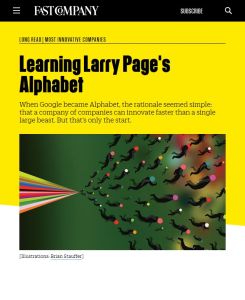
Fast Company
Learning Larry Page's Alphabet
Fast Company, 2016
What's inside?
Taken as a whole, Google co-founder Larry Page’s Alphabet is enigmatic. Broken down into parts, it’s a revolution.
Recommendation
When Larry Page chose to transform Google into Alphabet in 2015, he created a unique structure to serve his dreams of superior and more “focused” innovation. Fast Company staff offer expert analysis of six core aspects of Alphabet’s larger vision, each exemplified by the models and practices of one of six other leading organizations, including Nike, Apple and GE. In this way, Fast Company helps make Alphabet less of an enigma. getAbstract recommends this analysis to tech trend-watchers and those interested in innovative corporate restructuring models.
Take-Aways
- Alphabet is a company made up of companies – eleven in all – of which Larry Page’s original business, Google, is only one.
- By making Google a distinct entity within the conglomerate , Alphabet aims to avoid the mistakes of Microsoft.
- Alphabet wants to create a “mythology” around itself and its “moonshot” ideas.
- Alphabet seeks to emulate Apple in terms of developing tech that brings “hardware, software and services” together in a single product.
- By breaking his single organization into smaller pieces, Page maintains a grand scale with Alphabet while enabling greater focus and adaptability.
Summary
Years before Google co-founder Larry Page chose to transform Google into Alphabet, an organization now comprising eleven distinct entities, he mused on the idea that more innovation might occur if Google could enable greater autonomy for its various projects. With Alphabet, Page has created a unique corporate structure that puts this notion to the test. But why Page supports this new organizational model and how the various parts of Alphabet work together is less evident. Still, it’s possible to gain a better understanding of Alphabet as a whole if you see some of its individual components in relation to the corporate models of six other important organizations, including Nike, Apple and GE.
“Alphabet is itself a moonshot, hoping to overcome a raft of technological, social, and financial challenges endemic to a world of increasing change.”
First, Alphabet aims to avoid the mistakes made by Microsoft, a company that was never able to match the success of its Windows software with any of its follow-up ventures. By making Google a distinct entity, Alphabet discourages comparisons between Google’s profits and those of Alphabet’s other entities, while simultaneously indicating it still can grow in a variety of areas.
“The new conglomerate is theoretically designed to make change happen faster.”
Additionally, Alphabet looks to create a “mythology” around itself and its “moonshot” ideas, much as Nike does with its “Innovation Kitchen.” In this way, wild ideas – regardless of their success – not only encourage innovation, but also serve as a form of marketing for Alphabet. In a way similar to General Electric, Alphabet wants to develop businesses that turn its virtual technologies into physical realities – for example, with self-driving cars and drones. Another critical component to Alphabet’s restructuring involves the adoption of Apple’s practice of developing technology that brings “hardware, software, and services” together in a single product. Alphabet hopes to compete with Facebook in terms of innovating the mobile web: finding ways to make in-app advertising more seamless and profitable and creating faster, more mobile web pages similar to apps.
“He wants to make the world a better place – with electric cars and smart cities and universal Internet access and no more disease – and also find lucrative new businesses that keep the company part of the present and future.”
Ultimately, Alphabet’s structure aims to make innovation happen at a faster pace. By breaking his single organization into smaller pieces, Page maintains a grand, transformative scale for Alphabet while, at the same time, enabling greater focus and adaptability.
About the Author
Fast Company is a progressive business media brand, whose publications offer a unique editorial focus on innovation in technology, ethonomics (ethical economics), leadership and design.
This document is restricted to personal use only.
My Highlights
Did you like this summary?
Read the articleThis summary has been shared with you by getAbstract.
We find, rate and summarize relevant knowledge to help people make better decisions in business and in their private lives.
Already a customer? Log in here.
















Comment on this summary